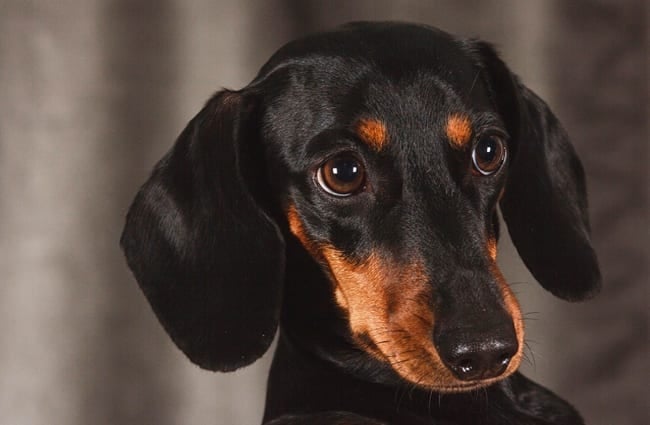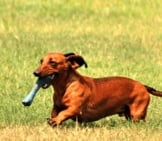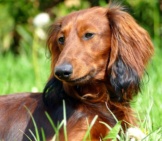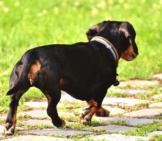The dachshund, also known as the “wiener dog,” or “sausage dog,” is a short-legged badger hunter from Germany. This lovable little dog comes in two sizes and three coat types, adding to their appeal. These dogs are alert and can be barky, charming people with their spunk. Though most dachshunds have long left their history as burrowing badger-hunters, they retain the low body and cleverness required of that work. Read on to learn more about the dachshund.
Description of the Dachshund
These dogs are famously long and low to the ground, with almost comically short legs. They are surprisingly strong with a startling, loud bark that betrays them as true hounds. This loud bark also helped human hunters locate their dogs while they chased after underground quarry.
This breed was originally smooth-coated, but a wire-coated variety was produced to work better in brambles and briars. A long-coated version of the breed appeared in colder climates.
The miniature dachshund was probably developed for hunting smaller animals, like rabbits. The larger “standard” size is still much smaller than a badger. The breed’s success as a hunter is a true testament to their courage and tenacity as hunters.
Dachshunds come in a wide variety of colors and patterns, ranging from a classic red or black-and-tan coat, to the striking merle, brindle, and piebald colorations.
Life Expectancy and Size
The dachshund generally lives into its early to mid teens, with an average lifespan of 12 to 16 years. Well-bred dogs that avoid spinal issues may live even longer.
The standard dachshund stands just 8 to 9 inches tall. Despite being bred to hunt badgers that weigh up to 40 pounds, these dogs generally weigh just 16 to 32 pounds. The miniature stands just 5 to 6 inches tall and weighs under 11 pounds.
Both sizes of wiener dog are vulnerable to weight gain, which can result in spinal issues. Keeping this breed slim is one of the best ways to extend lifespan.
Protective Ability
This breed is known for its bark, but is certainly no one’s first choice as a guard dog. They range from outgoing to suspicious with strangers. This breed tends to bark at people due to a lack of confidence, rather than a true desire to protect. Their short legs certainly don’t help them scare off any intruders!
Training
The dachshund is clever, and can be a quick learner when paired with a good teacher. Their keen nose and sense of purpose when scenting for prey can make them difficult to train outdoors. A strong foundation in reward- and relationship-based training will help ensure that your dachshund pays attention to you in distracting situations.
They do best with reward-based training, and may choose to avoid or ignore you if you resort to correction-based training.
Dachshunds excel at nosework, and barn hunt in particular, thanks to a keen nose and a desire to hunt. They can be successfully trained in nearly any dog sport around, but should avoid agility or dock diving. Jumping is just too hard on their backs, and they’re often terrible swimmers.
Energy Level
It’s easy to think that dachshunds don’t need much exercise. They’ve got short legs and are barely larger than a cat – yet this breed needs two moderate walks per day at a minimum. They also enjoy searching for hidden treats, and playing with puzzle feeders while you’re at work.
Some level of physical activity is absolutely necessary to strengthen their back muscles, and prevent injury as they age.
What Living with a Dachshund is Like
There’s a reason this dog is a popular first-time dog for many owners. This breed is generally cheery, relatively easy to exercise, and well-suited to the average home. That said, their loud barks and desire to dash off in search of prey can make these dogs ill-suited to apartment living.
With proper socialization, the dachshund can be a great choice for homes with well-behaved kids. The more fragile miniature dachshund is less well-suited to homes with rough or exuberant children.
As long as they get enough opportunities to socialize with people, and go outside for the bathroom, the dachshund does quite well in busy homes. They enjoy being around their people, but don’t need constant exercise.
This breed isn’t a good choice for homes that want an athletic companion to join on hikes or jogs. When well-bred and well-exercised, these dogs have fewer health problems than some other small breeds.
Care of the Dachshund
These hardy dogs are well-suited to a variety of environments and lifestyles. With so many coat types to choose from, it’s relatively easy to find a dachshund whose care suits your lifestyle. When well-bred and well-exercised, these dogs have fewer health problems than some other small breeds.
Environmental Needs
The smooth-coated dachshund does not do well in the cold, but the long-haired variety is quite tough in winter. The wire-haired variety fall somewhere in the middle. Unsurprisingly, mini dachshunds are a bit less cold-tolerant than their larger cousins. No variety of dachshund is well-suited to deep snow, and they’re notoriously poor swimmers.
Exercise Needs
As a hunting dog, the dachshund still requires adequate exercise. Their long backs are vulnerable to injury, and it’s important to give them exercise in the form of walking on uneven surfaces to strengthen supporting muscles.
While they often enjoy running and frolicking like other dogs, these dogs should be prevented from jumping up or down from any sort of height, and from jumping across from one piece of furniture to another, as these activities may seriously injure their spines.
Regular walks, especially on uneven surfaces, should be a regular activity for your wiener dog. Pair this with puzzle toys while you’re at work, and a few hidden treats per evening, and you’ll easily cover the mental and physical exercise needs of this breed.
Just allowing your wiener dog to run around the house will not keep his back muscles sufficiently strong to avoid pain or injury later in life.
Shedding and Grooming
Shedding and grooming in dachshunds varies widely. The short-haired variety needs minimal grooming beyond the regular bathing, ear cleaning, and nail trims that all dogs require.
The wire-haired variety may need a bit more brushing, but is still quite low-maintenance. Although the long-haired variety is nowhere near as challenging as a pomeranian or poodle, they require much more diligent brushing.
Ideal Home Environment
This breed is popular with urbanites, families with children, and older owners. In short, unless you’re looking for an athletic companion, the dachshund might fit into your home. As long as you’re ok with some barking, and don’t mind taking detours on your walks for sniffing, the dachshund is a relatively easy roommate to adjust to.
This dog will do particularly well in a home with no stairs, or with an owner willing to help them avoid jumping.
Health Concerns
This breed is generally quite healthy, aside from one big area of concern – their backs. The long, low shape of this dog is incredibly cute, but is also a source of potential injury and pain.
Find a breeder that is conscientious of musculoskeletal issues, particularly intervertebral disc disease. Once your dog is in your home, you can help prevent injury by discouraging him from jumping up or down from anything, or across furniture.
Finally, help support your dachshund’s musculoskeletal system by maintaining him at a healthy weight and building muscle around his spine.
Behavior Problems
This breed can be barky, there’s no way around it. Otherwise, these dogs are not particularly well-known for behavior concerns.
That said, some owners forget that their wiener dogs will only be friendly with others if they’re taught to be friendly. Starting out in a good puppy kindergarten, and continuing to teach your dog to calmly interact with (or ignore) strange people and dogs, will prevent any aggression or fearfulness later in life.




























![Red Angus Closeup of a beautiful Red Angus cowPhoto by: U.S. Department of Agriculture [pubic domain]https://creativecommons.org/licenses/by/2.0/](https://animals.net/wp-content/uploads/2020/03/Red-Angus-4-100x75.jpg)

